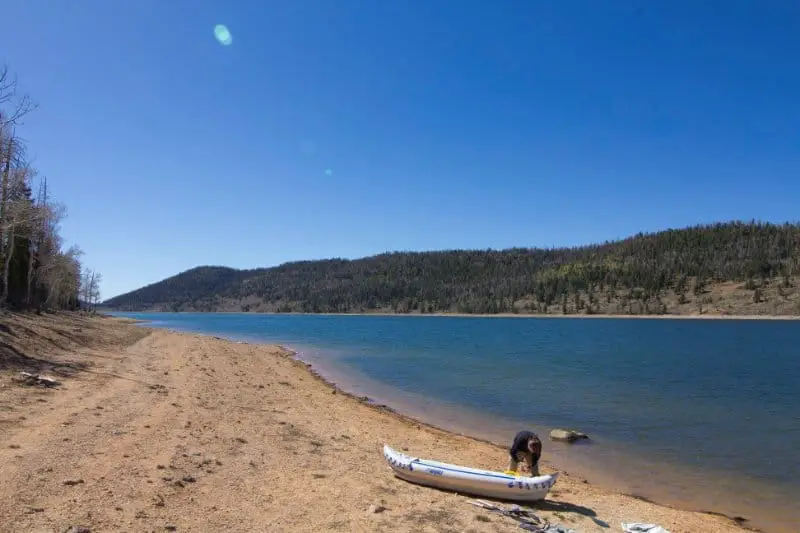

Andy is a jack-of-all-adventures, master of none. Depending on the season, you might find him rock climbing, trail running, kayaking, skiing, mountain biking, surfing or good ol’ hiking.

This Gear List is for beginner and intermediate kayakers interested in inflatable kayaking on lakes and rivers. With the right kayak, you can paddle up to Class 3 or 4 whitewater!

With the right inflatable kayak, you can explore any of the following:
You can enjoy overnight adventure trips. And with a premium inflatable whitewater or expedition kayak, you can even tackle Class 3 or Class 4 whitewater!
Take it from me. I’ve paddled the banks of Lake Superior, the kelp forests of California, the oyster beds of the Gulf of Mexico, the mangroves of the Florida Everglades, the surf off the Outer Banks, the bird sanctuaries of the Mississippi, the slot canyons of Lake Powell, the trout-laden spring waters of the Current River, and the whitewater rapids of the Colorado.
You really can do almost anything in an inflatable kayak!
I love inflatable kayaking. It’s allowed me to travel on some of the biggest lakes and rivers in the country. But like every adventure activity, it does have its pros and cons.
By their nature, inflatable kayaks excel at “boofing” on short drops and cresting over standing waves. But they can’t roll or surf as well as hardshells. This is one reason they are preferred for guided trips: Inflatable kayaks are more stable in the water than most hardshells. But that stability comes with a loss of agility.
But unless you’re an expert kayaker, ignore everything I said. Many inflatable kayaks are far more capable than you and me!

You can drown. You can break a leg. You can smash your skull. Water is dangerous, people!
The two biggest hazards on rivers are holes and strainers.
A full description of safety while inflatable kayaking is beyond the scope of this article. Dangers include everything from drowning to hypothermia to bacterial infection.
Here are several of my personal recommendations:
Before I go any further, we need to talk about inflatable kayaks themselves, because there are a LOT of misconceptions about these watercraft. I’ve paddled thousands of miles in my Sea Eagle 330 everywhere from the Gulf of Mexico surf to Colorado whitewater rivers, and the questions never cease!
If you already own a hardshell kayak, you have to accept that an inflatable kayak is really a hybrid between a kayak and a canoe.
Despite these disadvantages, there’s a lot to love about inflatable kayaking! The big benefit is ease of transportation! You can stash your boat in your backseat, the trunk, a roof rack, cargo carrier, or check it in as baggage on an airplane or train.
Most inflatable single or tandem kayaks weigh 50-100 lbs once packed up. When packed up, they’re not too difficult to carry for up to 100 yards. Any further than that, and you’re better off dragging or portaging.
| EQUIPMENT | COST | NOTES |
|---|---|---|
| REQUIRED | ||
| Kayak | $320 - $2,200 | See Gear Notes |
| Pump | (Often Included) | Get both manual and electric pumps! |
| Spray Skirt | (Often Included) | If available with model |
| Paddle | $30 - $100 | Make sure you can twist the ferrule on the shaft so you can feather the blade for long-distance trips. |
| Seat | (Often Included) | See Gear Notes |
| Helmet | $60 - $150 | Certified to BS EN 1385:2012 standard. |
| Life Jacket | $20 - $80 | USCG-approved. Must still allow flexibility for swimming! |
| Wetsuit | $50 - $200 | Look for used models on Ebay! | Optional in warm water AND weather conditions | 2mm or 3/2mm is recommended for colder water. |
| Water Shoes | $5 - $50 | Flip flops or booties for easy water | Soled water shoes for whitewater. |
| Safety Whistle | $5 | Wear as a lanyard. |
| Dry Bag | $30-$50 | Recommended size 20-50 liters. Bring 2-3 sizes, including single zippered dry bag for smartphone. And no, Zip-Loc bags don’t work! |
| Towline | $5 | At least 10 feet of paracord if you need to anchor your craft. |
| Water Bottle/Bladder | $10 | Plan on 3 liters per person per day. |
| Change of Dry Clothes | Free | Keep in vehicle or in dry bag! |
| Registration | Varies | Many states require registration for all watercraft, even small inflatable kayaks! This is partially to protect waterways from invasive species. |
| OPTIONAL | ||
| Quick-Dry Towel | $10 | |
| Paddle Float/Paddle Leash | $10 | Everyone drops their paddle eventually! |
| Headlamp | $30 | Because you can’t hold a flashlight when you’re paddling. |
| Sponge | $10 | For sopping up water. |
| Hat | $20-$50 | Wide-brimmed is best! |
This Gear List does not include the 10 Essentials, which you should bring on any adventure outing!
If you’re planning an overnight trip, you’ll need to bring quite a bit more, obviously. Plan accordingly. If you’re avoiding high-adrenaline whitewater, you can attach a floating cargo raft to the stern of your craft and lash your equipment to it!
I highly recommend you avoid the cheap $100 inflatable kayaks found at Big Box stores like Walmart. These are squirrely watercraft only suited for flatwater kayaking in good weather. Do yourself a favor and invest in a high-quality inflatable, such as a Sea Eagle, Bote, Aire, or AquaGlide. Only buy an Intex if it’s one of their premium lines, like the Excursion series.
You get what you pay for, and a $100 kayak isn’t good for anything except paddling around an open lake.
(I know, I know, this Gear List is all about affordable kayaking. And I support saving money wherever you can – except the kayak! Buy the nicest one you can get your hands on. Call the company and ask about show models, demos, returns, whatever. Offer a bribe. Do whatever you need to.)
***
I own a Sea Eagle 330. It’s rated for Class 3 whitewater (which I can attest to). It’s a great kayak! But it does have its limitations.
One of the big differences is pressure. In rough water, my 330 flops around like a half-boiled noodle. More expensive inflatable kayaks can be inflated to a higher pressure, which makes them more rigid. You can really tell the difference when the water turns frothy! I’d like to upgrade to the Explorer series.
Here are some more recommendations for choosing an inflatable kayak:


Speaking as someone who hates his seats … don’t get cheap seats. They’re not worth it.
My seats are simple inflatables, like a kid’s water wings. They just never hold air for more than an hour or two. Then I get to sit in 2 inches of frigid water for the rest of the trip, cursing my cheapskate-ness.
Your seat should strap or buckle in place. And it should have excellent back support. These are both critical features for rough water and long excursions.

Copyright 2021 – Adventure on the Cheap (SRVS)